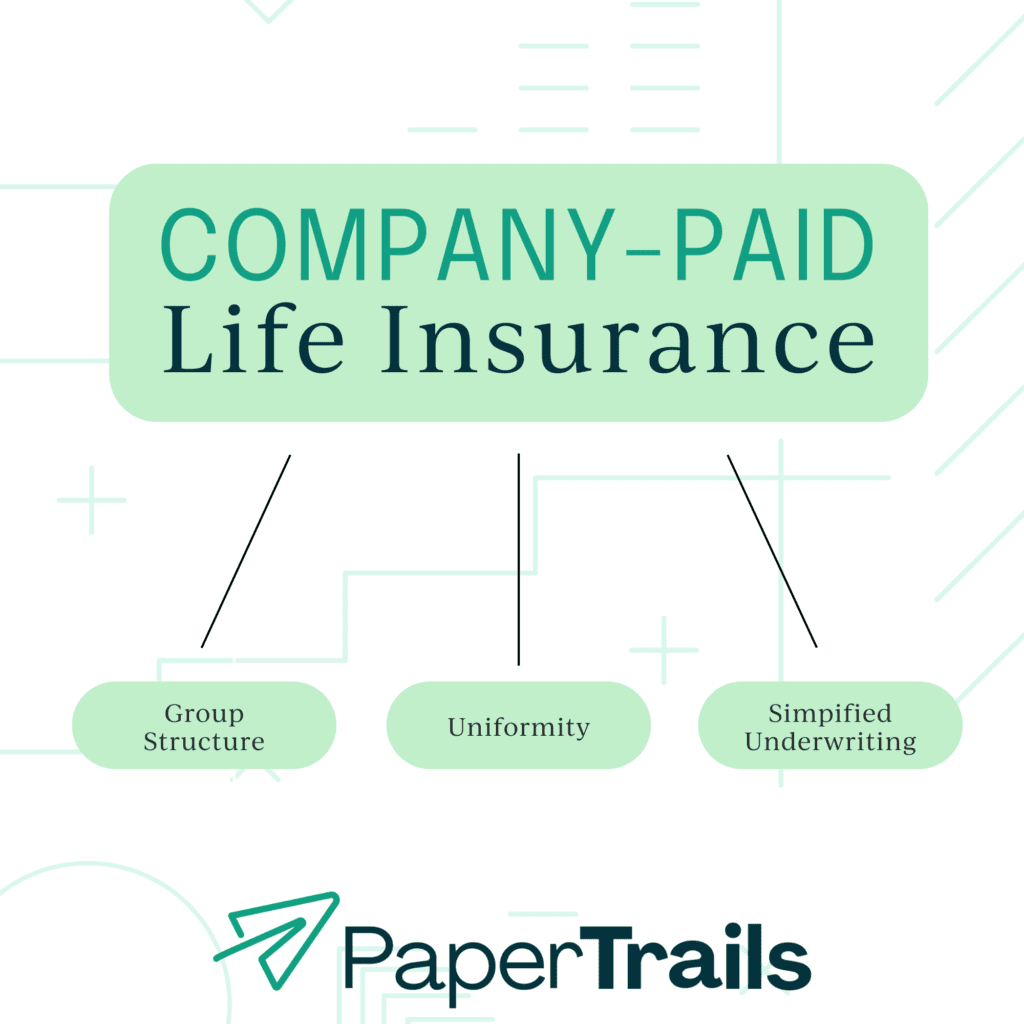For small business owners and HR managers, offering any type of fringe benefits to employees is a strategic move. Not only does it enhance job satisfaction and employee retention, but it can also give your company a competitive edge in the hiring market. Among the benefits considered, company-paid life insurance often emerges as a key contender. But what exactly does it entail?
Below, we dive into the nitty-gritty of company-paid life insurance, answering some of the most pressing questions on the minds of small business leaders. At Paper Trails, we strive to provide small business owners and HR managers like you with the resources and information necessary to make informed decisions for your business and its’ employees. By the time you finish reading this article, you should have a better understanding of what company-paid life insurance is and the pros and cons of offering and paying for life insurance for your employees.
Let’s get started!
What is company-paid life insurance?
Company-paid life insurance, also known as employer-provided life insurance or group life insurance, is a cornerstone fringe benefit for many employees. As the name suggests, it’s a type of life insurance where the employer bears the primary cost of the premiums. By doing so, the company provides a safety net for its employees, ensuring that their beneficiaries will receive financial assistance in the event of the employee’s untimely demise.

What does it entail?
Let’s take a look at some further details of company-paid life insurance.
- Group Policy Structure: Unlike individual life insurance policies, company-paid life insurance typically covers a group of people – the employees. This structure allows for reduced administration costs and often leads to lower premium rates.
- Uniformity: While there can be variations based on salary or seniority, the coverage amount is often uniform for a large group of employees. This ensures that all employees, regardless of their health or age, have access to some level of coverage.
- Simplified Underwriting: One of the advantages for employees is that company-paid life insurance policies often do not require a medical examination. While there might be a few health-related questions, the underwriting process is generally more lenient than individual policies.
How does company-paid life insurance work?
A company-paid life insurance policy functions as a collective term life insurance policy for employees. The employer typically pays the premiums, and in the event of an employee’s death during the policy term, a predetermined death benefit is paid out to the employee’s named beneficiaries.
There are often certain conditions attached:
- The employee may need to be with the company for a certain duration.
- Coverage might cease or require conversion to an individual policy if the employee leaves the company.
- Some policies may offer additional riders or benefits for added protection.
Can a business pay for life insurance?
Absolutely. Businesses can pay for life insurance policies for their employees. In fact, for many businesses, providing life insurance is a strategic move to offer competitive compensation packages and ensure employee well-being. The premiums for such policies are typically deductible as a business expense, but it’s always advisable to consult with a tax professional to understand the specifics for your business and region.
What are the benefits of company-paid life insurance?
There are pros and cons to this type of insurance for both employees and employers. Let’s take a look.
Employees
Obtaining life insurance as an employer comes with its pros and cons:
Pros:
- Cost-Efficiency: Often, group rates are more affordable than individual policies.
- Convenience: Automatic payroll deductions and less rigorous health checks.
- Instant Coverage: Employees usually receive coverage quickly without extensive medical examinations.
Cons:
- Limited Customization: Group policies may not offer the flexibility to choose specific terms or riders.
- Dependent on Employment: If you leave or lose your job, coverage might cease.
- May Not Be Enough: The provided coverage might not meet the full needs of every individual.
Employers
Offering life insurance through as an employer comes with its pros and cons:
Pros:
- Enhanced Recruitment and Retention: Offering life insurance can make a company more attractive to potential hires. It’s a tangible representation of an employer’s commitment to employee well-being, which can lead to increased loyalty and reduced turnover.
- Tax Advantages: In many jurisdictions, the premiums that a company pays for group life insurance policies can be tax-deductible. This provides businesses with a way to offer benefits while also realizing tax savings.
- Group Rates: Due to the bulk purchase nature of group life insurance, the per-person premium is often lower than individual rates. This allows employers to provide a valuable benefit at a reduced cost.
Cons:
- Cost Implications: Even with group rates, premium payments can add up, especially for larger companies or businesses that choose high coverage amounts.
- Administrative Challenges: Though generally more straightforward than managing individual policies, administering group life insurance still requires work. Employers need to ensure timely premium payments, manage policy renewals, and address employee queries.
- Coverage Limitations: Company-paid policies might not cover situations like deaths resulting from high-risk hobbies or pre-existing conditions. Such exclusions can lead to misunderstandings and grievances if not clearly communicated.
Conclusion
In conclusion, while an employer-provided life insurance policy can be a valuable benefit, it’s essential for both employers and employees to understand its intricacies. For small business owners and HR managers, offering such a benefit can set your company apart. Still, always ensure that employees are educated about the scope and limitations of their coverage. Feel free to contact our team for more information on this topic.